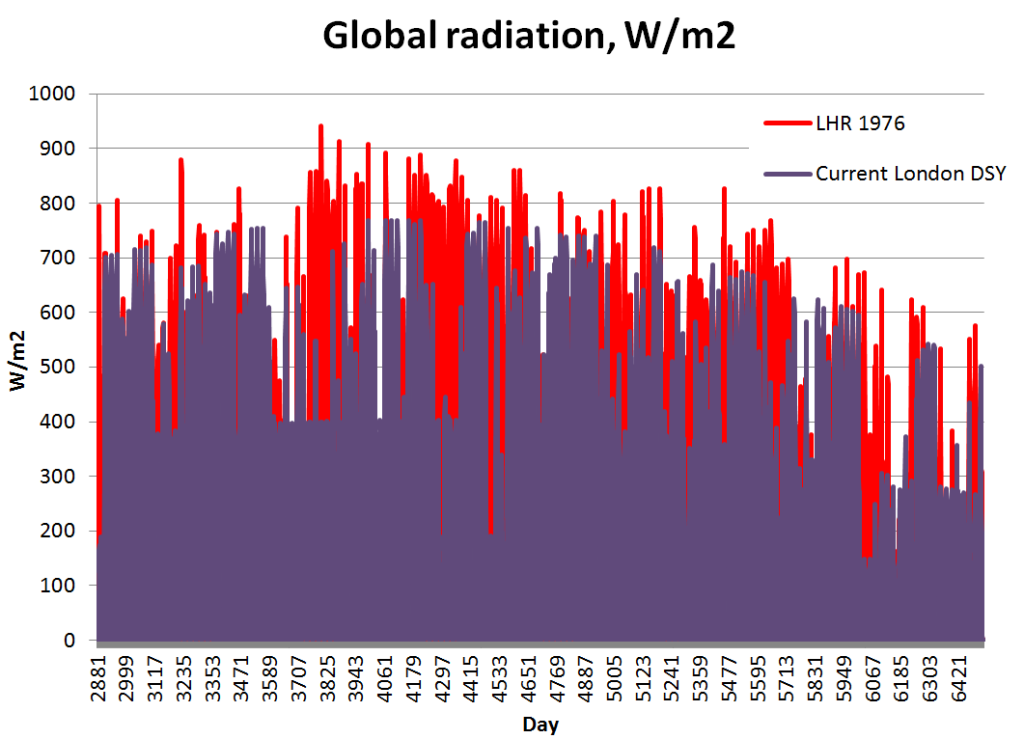Weather files and modelling overheating risk
This blog offers our thoughts on the impact of weather file selection on modelling domestic overheating risk. This is part of an ongoing discussion currently taking place regarding defining a complete methodology for predicting domestic overheating risk which factors in weather file selection, occupancy and gain profiles and setting the pass/fail thresholds.
The weather file used when modelling buildings can make a significant difference to the results. This is especially true when assessing overheating risk. Historically, CIBSE Design Summer Year (DSY) weather files have been used in the UK to assess summertime overheating risk. These files represent a hot, but not extreme summer (a 1 in 7 years heat event). However, these files may not be the most suitable for overheating assessment for a number of reasons:
– the client or design team may choose (or be required) to design for a different (lower) level of risk
– the climate is changing and they may not be representative of weather during the life of the building
– in built-up areas the Urban Heat Island (UHI) effect raises local temperatures relative to less built-up areas (particularly at night)
In London the GLA requires that modelling is carried out using weather data and guidance from CIBSE Design Summer Years for London (TM49: 2014). The guidance advises using weather files which account for both the UHI effect and for future climate change. In line with this the ‘GLA Energy Planning – Greater London Authority guidance‘ (April 2015) specifies that three different weather data files should be used in overheating analysis:
– 1976: a year with a prolonged period of sustained warmth.
– 1989: a moderately warm summer (current design year for London)
– 2003: a year with a very intense single warm spell.
The TM49 dataset contains each of these weather years for three London sites (urban, suburban and rural) in order to take account of the varying UHI effect. For buildings with long service lives or where overheating impacts are more critical, it is suggested that the building is modelled using more extreme (‘future’) weather data in addition to modelling against the three weather files above. The TM49 dataset includes future weather files for this purpose.
When predicting overheating risk, the compliance criteria used interact with the weather data used. The superseded CIBSE Guide A (2006) recommended assessing overheating in terms of the percentage of annual occupied hours in which a threshold temperature was exceeded (generally 26 ℃ for bedrooms and 28℃ for all other occupied areas). As the maximum threshold temperatures are fixed, this means it would becomes harder to pass when external temperatures increase (future weather files).
The current 2015 edition of CIBSE Guide A recommends that an ‘adaptive’ approach is used. (See TM52 for more details of the background and methodology). This assessment allows for people acclimatising to warmer outside temperatures during warm spells and so becoming more tolerant of higher indoor temperatures. Using an adaptive approach generally makes compliance easier with future weather files compared to the fixed ‘hours above threshold’ criteria, as the maximum allowable internal temperature increases with warmer outside temperatures.
Besides the external air temperature, solar radiation, which leads to solar gain has a significant impact on overheating risk. . For well insulated and highly glazed buildings the solar gain will affect the results to a greater extent. As an example, the CIBSE TM49 1976 London Heathrow weather file has significantly higher average and peak global radiation than the CIBSE 1989 Heathrow file (current London DSY).
It should also be noted that, as well as the weather file and overheating criteria used, the occupancy pattern will strongly affect the resulting overheating risk. Overheating criteria assess conditions during occupied hours only, any unoccupied hours will not be included in the assessment – no matter how high the internal temperatures! Therefore it is important that the occupancy pattern assumed is representative of the building use. Where this is unknown – for example in dwellings (where occupancy is hugely variable) – there is an argument that the highest reasonable usage should be assumed in order that the overheating assessment is not too lenient. The corollary of this is that is homes are unoccupied during the hottest part of the day they are also likely to have all the doors and windows sealed closed, which may exacerbate the daytime temperatures and make it more difficult for the building to cool in the evening once occupant return and do open the windows.
 Posted by Claire Das Bhaumik
Posted by Claire Das Bhaumik- Posted in Overheating, Research
 Mar, 31, 2016
Mar, 31, 2016 Comments Off on Weather files and modelling overheating risk
Comments Off on Weather files and modelling overheating risk

 Susie: 07972 263 676
Susie: 07972 263 676

 Join Us On In.com
Join Us On In.com
